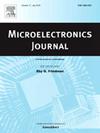A power-efficient spiking convolutional neural network accelerator based on temporal parallelism and streaming dataflow
IF 1.9
3区 工程技术
Q3 ENGINEERING, ELECTRICAL & ELECTRONIC
引用次数: 0
Abstract
The spiking convolutional neural network (SCNN) accelerator is well-suited for intelligent edge devices due to its low power consumption. However, there is still room for improvement in its power efficiency, particularly in terms of computation and memory optimization. In this paper, a temporal parallelism method is proposed to enhance power efficiency by minimizing unnecessary data movement. A streaming dataflow mechanism is introduced to pipeline the computations of convolution and pooling layers. Additionally, a configurable decomposition technique is designed to support arbitrary kernel sizes. The proposed accelerator is implemented on a Xilinx ZCU102 FPGA development board with a clock frequency of 200 MHz. Experiment results show that the proposed design consumes only 1.69 W of power while achieving a peak performance of 921.6 GOPS, resulting in a power efficiency of 545 GOPS per watt.
一种基于时间并行和流数据流的高能效尖峰卷积神经网络加速器
尖峰卷积神经网络(SCNN)加速器具有功耗低的特点,非常适合应用于智能边缘设备。然而,它的功率效率仍有改进的空间,特别是在计算和内存优化方面。本文提出了一种时间并行方法,通过减少不必要的数据移动来提高功率效率。引入了一种流数据流机制,将卷积层和池化层的计算流水线化。此外,还设计了一种可配置的分解技术来支持任意的内核大小。该加速器在Xilinx ZCU102 FPGA开发板上实现,时钟频率为200mhz。实验结果表明,该设计功耗仅为1.69 W,峰值性能为921.6 GOPS,功率效率为545 GOPS / W。
本文章由计算机程序翻译,如有差异,请以英文原文为准。
求助全文
约1分钟内获得全文
求助全文
来源期刊

Microelectronics Journal
工程技术-工程:电子与电气
CiteScore
4.00
自引率
27.30%
发文量
222
审稿时长
43 days
期刊介绍:
Published since 1969, the Microelectronics Journal is an international forum for the dissemination of research and applications of microelectronic systems, circuits, and emerging technologies. Papers published in the Microelectronics Journal have undergone peer review to ensure originality, relevance, and timeliness. The journal thus provides a worldwide, regular, and comprehensive update on microelectronic circuits and systems.
The Microelectronics Journal invites papers describing significant research and applications in all of the areas listed below. Comprehensive review/survey papers covering recent developments will also be considered. The Microelectronics Journal covers circuits and systems. This topic includes but is not limited to: Analog, digital, mixed, and RF circuits and related design methodologies; Logic, architectural, and system level synthesis; Testing, design for testability, built-in self-test; Area, power, and thermal analysis and design; Mixed-domain simulation and design; Embedded systems; Non-von Neumann computing and related technologies and circuits; Design and test of high complexity systems integration; SoC, NoC, SIP, and NIP design and test; 3-D integration design and analysis; Emerging device technologies and circuits, such as FinFETs, SETs, spintronics, SFQ, MTJ, etc.
Application aspects such as signal and image processing including circuits for cryptography, sensors, and actuators including sensor networks, reliability and quality issues, and economic models are also welcome.
 求助内容:
求助内容: 应助结果提醒方式:
应助结果提醒方式:


